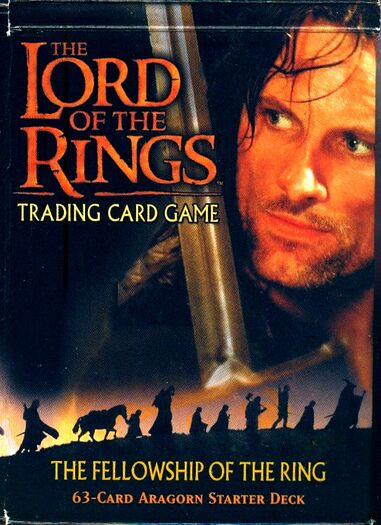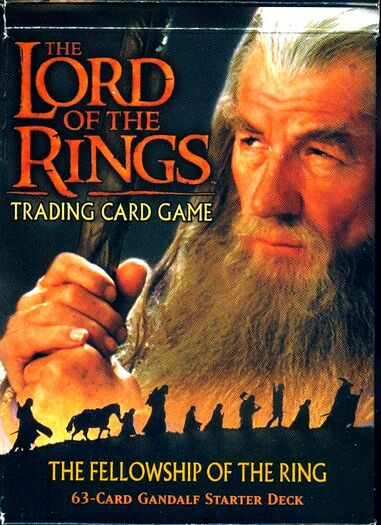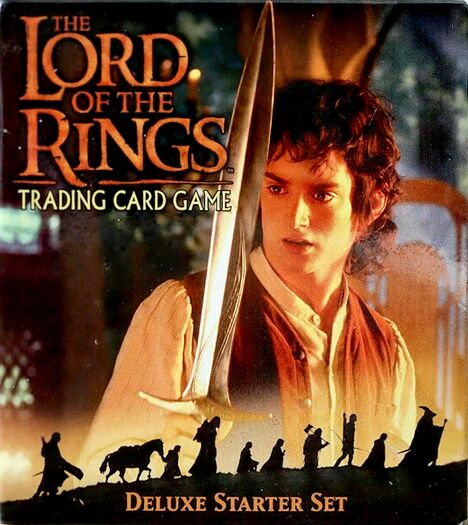The Fellowship of the Ring: Difference between revisions
No edit summary |
(edited the starter deck links to use images for links) |
||
| (12 intermediate revisions by 2 users not shown) | |||
| Line 1: | Line 1: | ||
__NOTOC__ | |||
{{NavBar|Fellowship of the Ring Index| [[Main Page]]|[[Promotional|Promotional Set]]|[[Mines of Moria]]}} | |||
{{SetTabs}} | |||
{{Set | {{Set | ||
|ID=1 | |ID=1 | ||
|Name=Fellowship of the Ring | |Name=The Fellowship of the Ring | ||
|Abbr=FotR | |||
|Creator=Decipher | |Creator=Decipher | ||
|ReleaseDate=2001 | |ReleaseDate=2001-11-06 | ||
|IsOfficial=Yes | |IsOfficial=Yes | ||
|SubsetOrder=S,M | |||
|Platforms=Paper, LotR-O, GEMP, mLOTRO, Tabletop Simulator, Lackey, gccg | |Platforms=Paper, LotR-O, GEMP, mLOTRO, Tabletop Simulator, Lackey, gccg | ||
}} | }} | ||
=The Fellowship of the | [[File:LOTR-EN01S001.0_card.jpg|frame|right|The premier Ring that one presumably Lords over.]] | ||
This was it. This was the set that kicked off [[The Lord of the Rings TCG]]. Released November 6th, 2001, one month before the theatrical release of the movie by the same name, '''The Fellowship of the Ring''' (commonly abbreviated as '''FOTR''') laid down the groundwork for every set that followed it. This was the first "base set", and it started a pattern that would define the Movie block regular release schedule: for each movie, one base set to lay down the foundation followed by two expansions to fill in the gaps. | |||
== Themes and Mechanics == | |||
FOTR took most of its direction cues from the dramatic combat conflicts of the first movie. {{C|Elven}} and {{C|Gondor}} cards used many scenes from the prologue battle with Sauron, while {{C|Moria}} and {{C|Isengard}} were spearheaded by the likes of {{Card|1R165}} and {{Card|1R127}}. Being a fresh new game, most strategies relied on simple interactions on one side or another, which worked well with the new player base. | |||
Many of the core mechanics took cues from the story of FOTR, which persisted throughout the lifetime of the game even when later blocks did not line up with their inclusion quite so well. For instance, [[Sanctuary|Sanctuaries]] being at site 3 and 6 lines up with Rivendell and Lothlorien; the [[Rule of 9]] restricting the number of companions that can be played comes straight from the Fellowship's canonical size; and an emphasis on protecting the [[Ring-bearer]], [[Frodo]], at the expense of all other companions. | |||
Because the cards were released a month before the movie itself did, New Line Cinema prevented Decipher from releasing images they considered "spoilers" until after the movie. As a result, FOTR included some "prophetic" cards that referenced other cards yet to be printed. {{Card|1C349}} was the only site 5 in the set, making it impossible to play without it, so you could imagine players' confusion as they looked down the spoiler sheet only to find that the Balrog was nowhere to be found! The first two versions of the Balrog were released in [[Mines of Moria]] four months later, but until then the site was a constant reminder of bigger and better things to come. Similarly, {{Card|Sam, Faithful Companion}} references {{Card|Bill the Pony}}, who was not released until [[Realms of the Elf-lords]]; and {{Card|Gandalf's Cart}} refers to [[Artifact]]s, which were not released until MOM and ROTEL. | |||
{{clear}} | |||
== Starter Decks == | |||
FOTR released with two standard starter decks, a pattern which would be followed by most following sets, and also included a Deluxe Starter Set. The Gandalf starter is a proto-[[Rainbow]] strategy paired with Moria, while Aragorn is a [[Ranger]] deck paired with Uruks. The two decks are not particularly well balanced, with the {{C|Gondor}} fellowship doing a much better job of surviving, due to the number of possessions which can be played on each companion, and the fact that the {{C|Moria}} deck suffers with only half of its usual combo, and interacting poorly with the starter-only discard shuffle rule. The Deluxe Starter Set pairs Hobbits with Nazgul. | |||
<gallery widths=300px heights=350px mode="packed"> | |||
File:Starter-01-Aragorn.jpg|link=Starter Decks/Fellowship Block#FOTR Aragorn Starter Deck|Click through to see the contents of the [[Starter_Decks/Fellowship_Block#FOTR_Aragorn_Starter_Deck|Aragorn Starter Deck]] | |||
File:Starter-01-Gandalf.jpg|link=Starter Decks/Fellowship Block#FOTR Gandalf Starter Deck|Click through to see the contents of the [[Starter_Decks/Fellowship_Block#FOTR_Gandalf_Starter_Deck|Gandalf Starter Deck]] | |||
File:Starter-01-Deluxe.jpg|link=Starter_Decks/Fellowship_Block#FOTR_Deluxe_Starter_Set|Click through to see the contents of the [[Starter_Decks/Fellowship_Block#FOTR_Deluxe_Starter_Set|Deluxe Starter Set]] | |||
<!--File:Rules-Starter-EN_Set-01.pdf|Click through for the FOTR Starter Rulebook PDF--> | |||
</gallery> | |||
{{clear}} | |||
[[File:LOTR-EN00M001.0_card.jpg|frame|right|A card used to promote the release. Note the early differences compared to the finalized {{C|Gandalf}} culture template, such as the flat Twilight icon.]] [[File:LOTR-EN00M002.0_card.jpg|frame|right|The reverse side. Note the early differences compared to the finalized {{C|Moria}} culture template, such as the switched Culture icon / background watermark and brighter / more saturated colors.]] | |||
== Cultures == | |||
As the premier set, this was the debut for each of the following cultures. All of the [[Free Peoples]] cultures would remain relevant throughout the game's lifetime, but each of the [[Shadow (Alignment)|Shadow]] cultures would wax and wane at different times. | |||
'''Free Peoples:''' | |||
* {{C|Dwarven}} | |||
* {{C|Elven}} | |||
* {{C|Dwarven}} | |||
* {{C|Gandalf}} | |||
* {{C|Gondor}} | |||
* {{C|Shire}} | |||
'' | '''Shadow:''' | ||
* {{C|Isengard}} | |||
* {{C|Moria}} | |||
* {{C|Sauron}} | |||
* {{C|Ringwraith}} | |||
== Notable Cards == | |||
* {{Card|Elrond, Lord of Rivendell}} | |||
* {{Card|The Last Alliance of Elves and Men}} | |||
* {{Card|Legolas, Greenleaf}} | |||
* {{Card|Shoulder to Shoulder}} | |||
* {{Card|Servant of the Secret Fire}} | |||
* {{Card|Sleep, Caradhras}} | |||
* {{Card|Aragorn, Ranger of the North}} | |||
* {{Card|Aragorn's Bow}} | |||
* {{Card|No Stranger to the Shadows}} | |||
* {{Card|What Are They?}} | |||
* {{Card|Greed}} | |||
* {{Card|Savagery to Match Their Numbers}} | |||
* {{Card|Goblin Armory}} | |||
* {{Card|Goblin Runner}} | |||
* {{Card|Goblin Scavengers}} | |||
* {{Card|Goblin Scimitar}} | |||
* {{Card|Blade Tip}} | |||
* {{Card|Black Breath}} | |||
* {{Card|The Pale Blade}} | |||
* {{Card|Ulaire Enquea, Lieutenant of Morgul}} | |||
* {{Card|Hobbit Stealth}} | |||
* {{Card|Sam, Son of Hamfast}} | |||
* {{Card|The Prancing Pony}} | |||
* {{Card|The Bridge of Khazad-dum}} | |||
{{Set Table}} | {{Set Table}} | ||
Latest revision as of 20:48, 29 January 2023
Back to Main Page |
Mines of Moria |
| The Fellowship of the Ring | |
|---|---|
| ID | 1 |
| Name | The Fellowship of the Ring |
| Creator | Decipher |
| Release Date | 2001-11-06 |
| Is Official | Yes |
| Platforms | Paper • LotR-O • GEMP • mLOTRO • Tabletop Simulator • Lackey • gccg |
| Notes | |
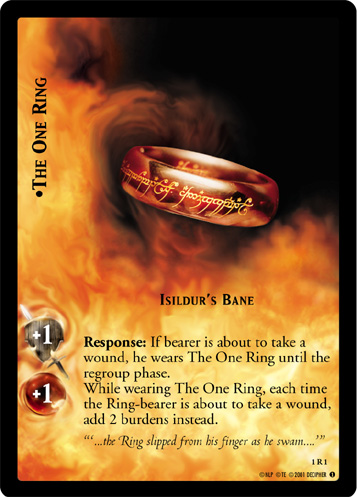
This was it. This was the set that kicked off The Lord of the Rings TCG. Released November 6th, 2001, one month before the theatrical release of the movie by the same name, The Fellowship of the Ring (commonly abbreviated as FOTR) laid down the groundwork for every set that followed it. This was the first "base set", and it started a pattern that would define the Movie block regular release schedule: for each movie, one base set to lay down the foundation followed by two expansions to fill in the gaps.
Themes and Mechanics[edit]
FOTR took most of its direction cues from the dramatic combat conflicts of the first movie. Elven and
Gondor cards used many scenes from the prologue battle with Sauron, while
Moria and
Isengard were spearheaded by the likes of Cave Troll of Moria, Scourge of the Black Pit (1R165)
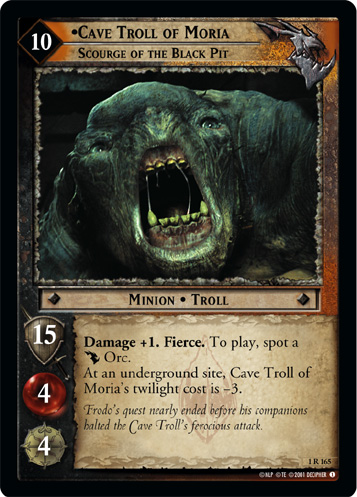 and Lurtz, Servant of Isengard (1R127)
and Lurtz, Servant of Isengard (1R127)
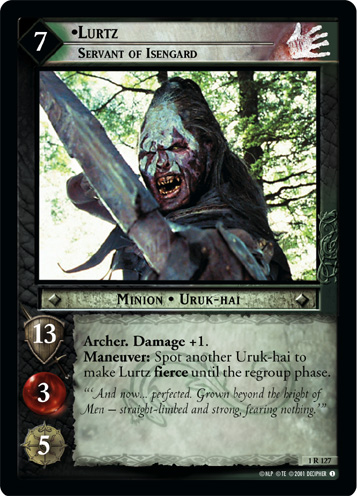 . Being a fresh new game, most strategies relied on simple interactions on one side or another, which worked well with the new player base.
. Being a fresh new game, most strategies relied on simple interactions on one side or another, which worked well with the new player base.
Many of the core mechanics took cues from the story of FOTR, which persisted throughout the lifetime of the game even when later blocks did not line up with their inclusion quite so well. For instance, Sanctuaries being at site 3 and 6 lines up with Rivendell and Lothlorien; the Rule of 9 restricting the number of companions that can be played comes straight from the Fellowship's canonical size; and an emphasis on protecting the Ring-bearer, Frodo, at the expense of all other companions.
Because the cards were released a month before the movie itself did, New Line Cinema prevented Decipher from releasing images they considered "spoilers" until after the movie. As a result, FOTR included some "prophetic" cards that referenced other cards yet to be printed. The Bridge of Khazad-dûm (1C349)
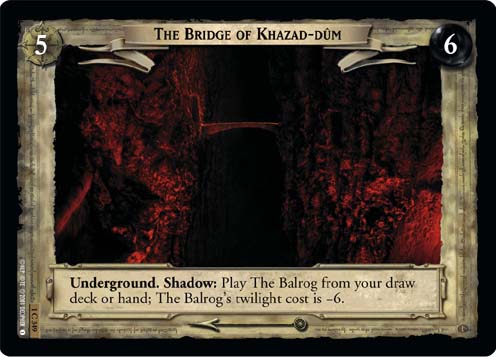 was the only site 5 in the set, making it impossible to play without it, so you could imagine players' confusion as they looked down the spoiler sheet only to find that the Balrog was nowhere to be found! The first two versions of the Balrog were released in Mines of Moria four months later, but until then the site was a constant reminder of bigger and better things to come. Similarly, Sam, Faithful Companion (1R310)
was the only site 5 in the set, making it impossible to play without it, so you could imagine players' confusion as they looked down the spoiler sheet only to find that the Balrog was nowhere to be found! The first two versions of the Balrog were released in Mines of Moria four months later, but until then the site was a constant reminder of bigger and better things to come. Similarly, Sam, Faithful Companion (1R310)
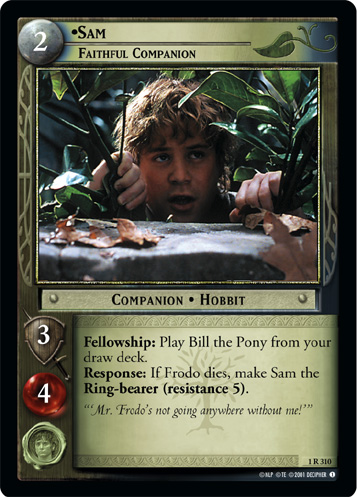 references Bill the Pony (3U106)
references Bill the Pony (3U106)
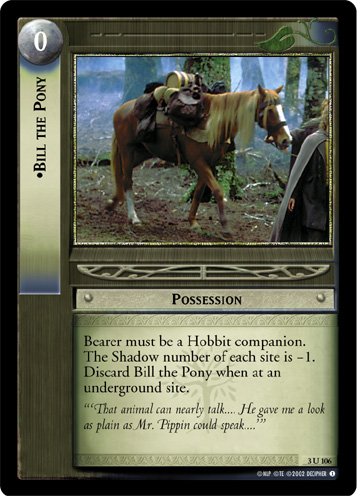 , who was not released until Realms of the Elf-lords; and Gandalf's Cart (1U73)
, who was not released until Realms of the Elf-lords; and Gandalf's Cart (1U73)
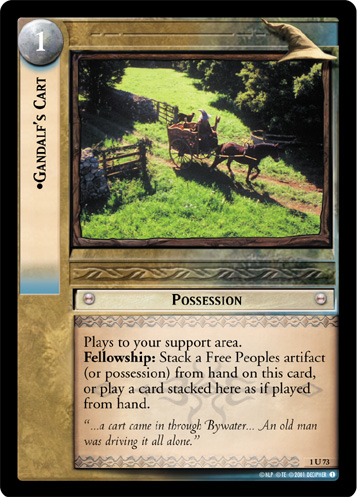 refers to Artifacts, which were not released until MOM and ROTEL.
refers to Artifacts, which were not released until MOM and ROTEL.
Starter Decks[edit]
FOTR released with two standard starter decks, a pattern which would be followed by most following sets, and also included a Deluxe Starter Set. The Gandalf starter is a proto-Rainbow strategy paired with Moria, while Aragorn is a Ranger deck paired with Uruks. The two decks are not particularly well balanced, with the Gondor fellowship doing a much better job of surviving, due to the number of possessions which can be played on each companion, and the fact that the
Moria deck suffers with only half of its usual combo, and interacting poorly with the starter-only discard shuffle rule. The Deluxe Starter Set pairs Hobbits with Nazgul.
-
Click through to see the contents of the Aragorn Starter Deck
-
Click through to see the contents of the Gandalf Starter Deck
-
Click through to see the contents of the Deluxe Starter Set
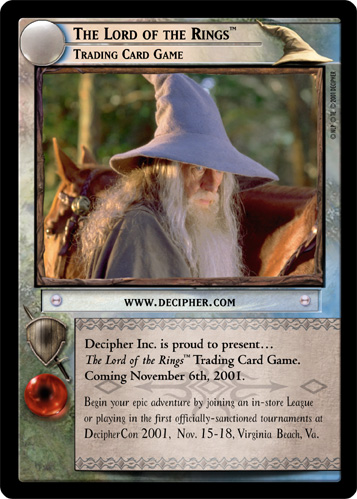
 Gandalf culture template, such as the flat Twilight icon.
Gandalf culture template, such as the flat Twilight icon.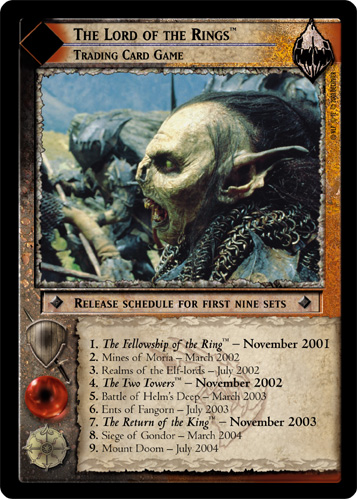
 Moria culture template, such as the switched Culture icon / background watermark and brighter / more saturated colors.
Moria culture template, such as the switched Culture icon / background watermark and brighter / more saturated colors.Cultures[edit]
As the premier set, this was the debut for each of the following cultures. All of the Free Peoples cultures would remain relevant throughout the game's lifetime, but each of the Shadow cultures would wax and wane at different times.
Free Peoples:
Shadow:
Notable Cards[edit]
- Elrond, Lord of Rivendell (1R40)
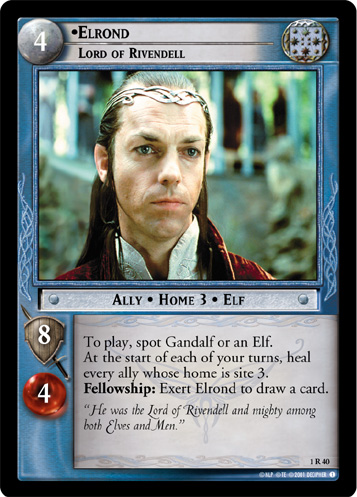
- The Last Alliance of Elves and Men (1R49)
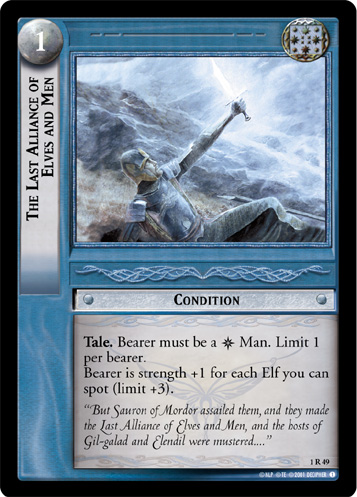
- Legolas, Greenleaf (1R50)
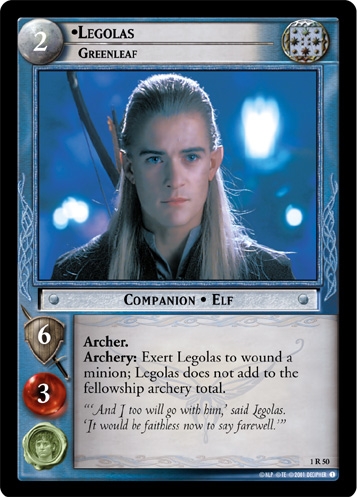
- Shoulder to Shoulder (1C59)
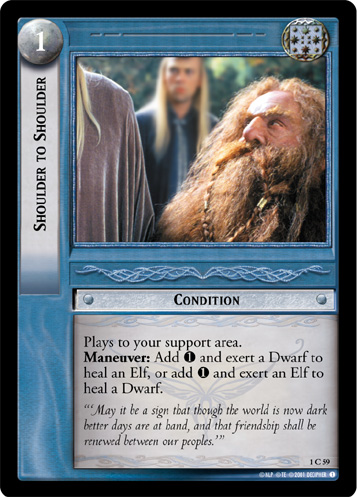
- Servant of the Secret Fire (1R83)
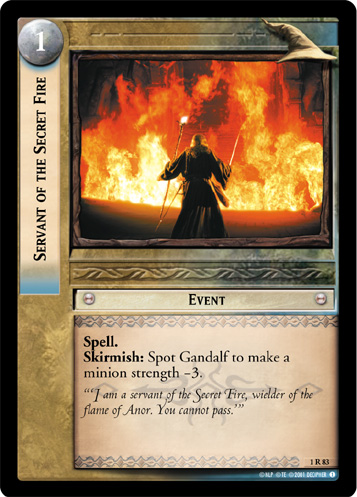
- Sleep, Caradhras (1C84)
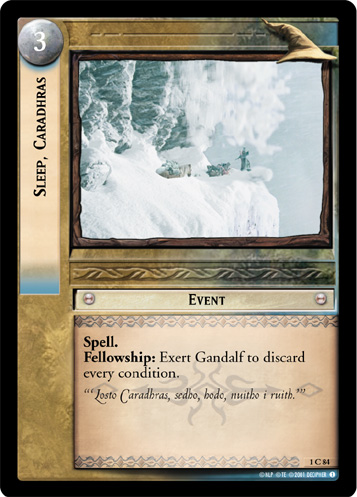
- Aragorn, Ranger of the North (1R89)
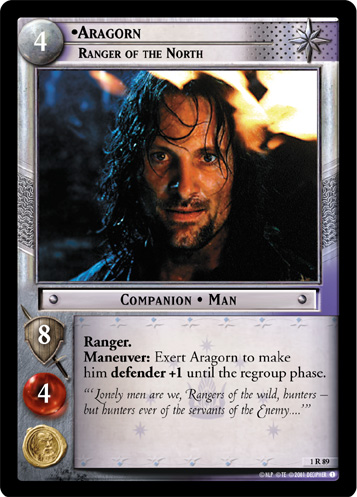
- Aragorn’s Bow (1R90)
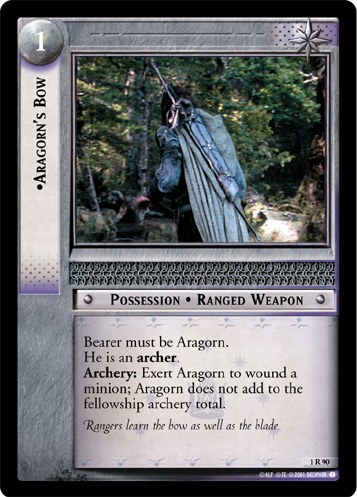
- No Stranger to the Shadows (1U108)
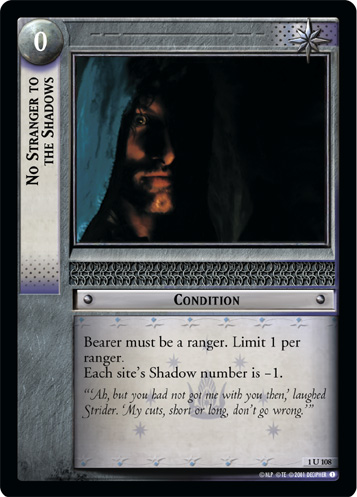
- What Are They? (1C119)
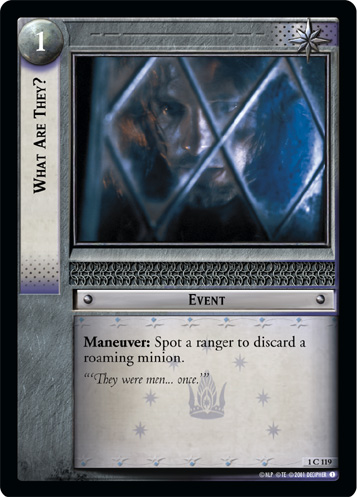
- Greed (1R125)
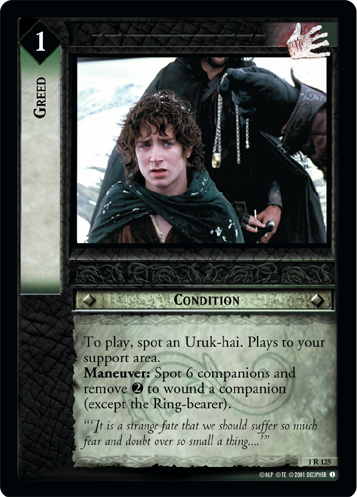
- Savagery to Match Their Numbers (1R139)
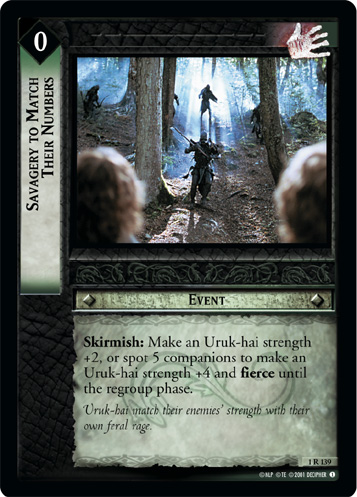
- Goblin Armory (1R173)
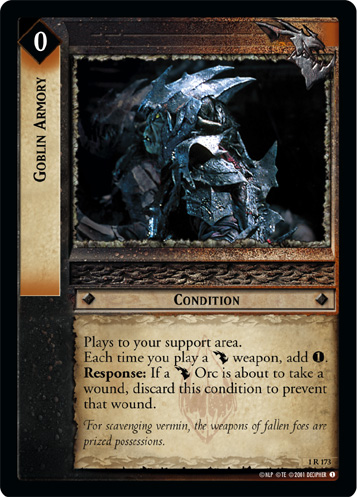
- Goblin Runner (1U178)
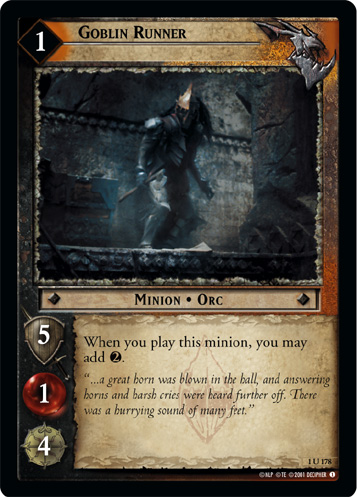
- Goblin Scavengers (1C179)
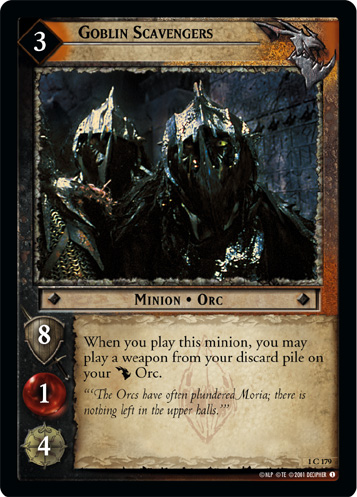
- Goblin Scimitar (1C180)
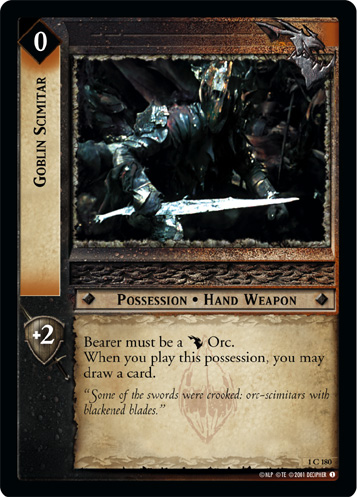
- Blade Tip (1U209)
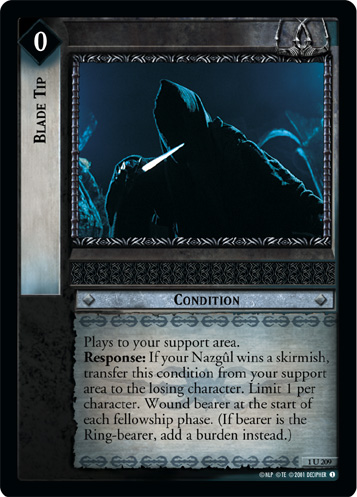
- Black Breath (1U207)
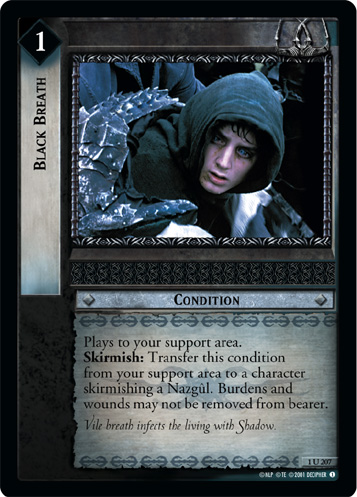
- The Pale Blade (1R221)
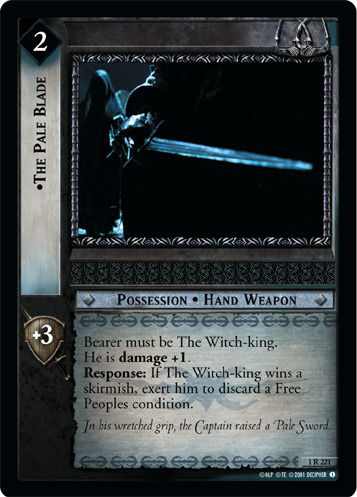
- Úlairë Enquëa, Lieutenant of Morgul (1U231)
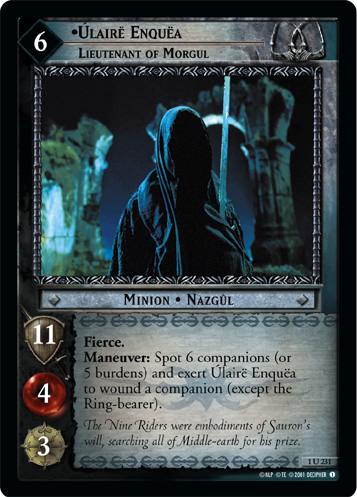
- Hobbit Stealth (1C298)
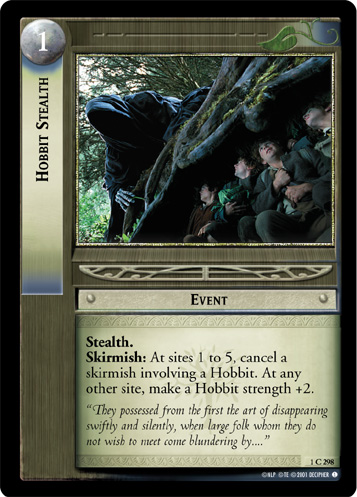
- Sam, Son of Hamfast (1C311)
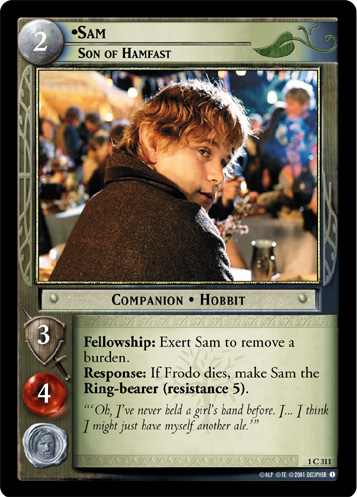
- The Prancing Pony (1U324)
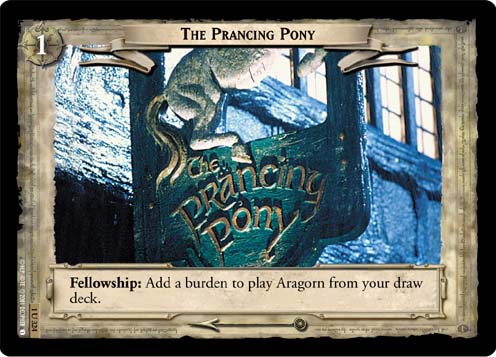
- The Bridge of Khazad-dûm (1C349)

